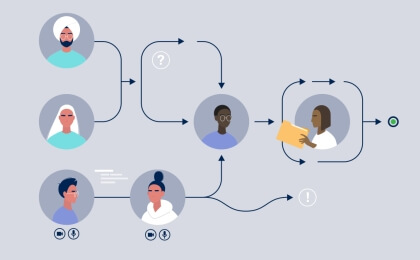Want to know the single most important factor that creates a more engaged, productive, and committed workforce? We won’t bury the lead: it’s value alignment between your organization and the people who work for you. Let’s dive in and see why prioritizing alignment, especially during hiring, helps you reach your organizational goals.
What is workplace alignment?
People often refer to company alignment as everyone working in tandem and understanding how their role impacts different business initiatives. While this goal-oriented view is certainly a result of company alignment, it’s not the cause.
True workplace alignment stems from cultural overlap between the personal beliefs your employees hold and your company values. Modern workers, especially Millennials and Gen Z, aren’t comfortable compromising their personal values for a paycheck. People desire work that is meaningful. In fact, a recent study by McKinsey & Company found that 70% of employees feel their sense of purpose is defined by the work they do. And when their work doesn’t feel purposeful? They leave to find a place where it does.
Think about your organizational values. They are the undercurrent that carries your business forward, driving the decisions you make and how you decide to execute them. Let’s look at an example of company-employee alignment. If your business strives to be highly innovative and cutting edge, you’d want to have a workforce made up of people who are, on average, more creative and achievement oriented.
Workplace alignment also ensures that your work environment matches with how your employees work best. Different people thrive in different environments, and your goal is to find folks who will flourish in the one you provide. When employees feel that your organization provides them with an ideal work environment, they are likely to stay with your company, make more significant contributions, and be highly engaged at work.
Creating an aligned workforce doesn’t happen overnight. It requires compassionate leadership that listens to the needs of their people. But one of the simplest ways to increase alignment in your organization is to check for that critical cultural overlap when you’re hiring.
How to prioritize alignment during recruitment
To create a highly functional workforce, you have to pay attention to the values and needs of your candidates. There are couple ways you can do this.
First, you can bring it up in interviews. You can ask candidates about a time when they embodied one of your core organizational values, or ask candidates to share what’s most important to them personally with a more open-ended response. Then ask your candidates directly to describe their ideal work environment looks like. Discuss preferred managerial styles, co-working styles, and other important factors.
For example, you can ask how they best like to receive appreciation for their work. Do they prefer public recognition of their efforts? Or do they feel a financial incentive is more motivating? While most candidates would like both (wouldn’t we all?), they tend to have a preference of one over the other as being more meaningful. Take note of these preferences and see who has the most in common with how your organization functions.
If you’re looking for a more systematic approach, consider using an assessment. For example, Criteria developed the Workplace Alignment Assessment that asks candidates to rank 20 common workplace factors in order of most to least important to represent their ideal work environment. Then, candidate responses are compared to your organization’s profile to assess the strength of the match. Plus, this assessment provides customized interview questions to explore the areas where your company and the candidate differ.
Why strong alignment makes all the difference
Alignment between your company’s core values and those of your employees results in stronger performance, higher job satisfaction, and longer tenure. If you’re looking to achieve stronger alignment, consider including an assessment and prioritizing culture questions in your interviews.
Employees who align with your company’s values and work environment you provide are better equipped to help you reach overarching organizational goals. Plus they’ll be happier at work. And happy employees are good for business, after all.




